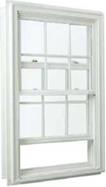Films Create Super Windows
Another way to control the flow of heat through a window is with suspended films. These films come in two varieties: high solar gain and low solar gain.
Because these films (similar to mylar) are so lightweight and thin, as many as three films can be suspended between two glass panes. The additional insulating spaces increase the insulating ability of the window, replicating the performance of three-, four-, or five-pane windows without the weight. Serious Windows® uses this approach to create high-performance windows with both high and low solar-gain properties. The company’s premium fixed window has an insulating value of R-11.1 (U-factor 0.09), nearly rivaling many wall insulations. The operable version of the window is R-7.1 (U-factor 0.14). Considering that the average insulating window is the equivalent of R-1 to R-3, Serious Windows live up to their name.
Solar gain and insulating values aren’t the only ways that windows save energy and keep you comfortable. Windows also control the view and the amount of natural light.
Daylighting, or window-placement strategies to maximize natural light, save money by reducing the need for electric lighting. Although placement is a design issue, window styles and glass properties affect the amount of light infiltration. The visible transmittance (VT) rating on the National Fenestration Rating Council’s label (p. 95) allows you to compare the amount of light that passes through windows, taking into account the light blocked by frames and grilles.
 Impact-Resistant Glass Offers Protection
Impact-Resistant Glass Offers Protection
Although they don’t affect a window’s energy performance, a few options can make you safer.
Tempered glass, for example, can be specified for windows located where someone could potentially fall into one. Many of these locations are covered by code and include windows within 18 in. of the floor, next to doors, in showers or bath areas, and along decks, patios, and walkways.
If you live in a coastal area—particularly along the Atlantic and Gulf coasts, where building codes demand protection during hurricanes—or in a tornado-prone area, you can specify impact-resistant glass. Using the same technology as car windshields, a plastic sheet is laminated between two pieces of glass so that the window maintains its integrity after the glass is broken.
Window frames can also be reinforced to withstand impact. Available in three different strengths (impact zones 2, 3, and 4), the toughest windows in impact zone 4 must withstand strikes from at least two 8-ft.-long 2x4s traveling at 50 ft. per second, followed by 9,000 cycles of negative and positive pressure simulating hurricane-force winds.
Windows That Keep the World at Bay
Manufacturers also offer variations of pebbled, frosted, and wavy glass that add privacy to bathrooms, bedrooms, and other sensitive spaces.
If you live near a busy road, near train tracks, or under a flight path, acoustic windows can take the edge off loud or constant noise. Even if they don’t readily advertise the fact, many window companies sell sound-attenuating windows. Residential "quiet" windows are likely to be rated with a sound transmission coefficient (STC). A typical double-pane window has an STC of 25 to
27. Every increase of 10 in the STC cuts the amount of sound transmitted by half. Companies such as Milgard®, Atrium®, Marvin, and Serious Windows have windows in the 40 to 47 STC range.






Leave a reply